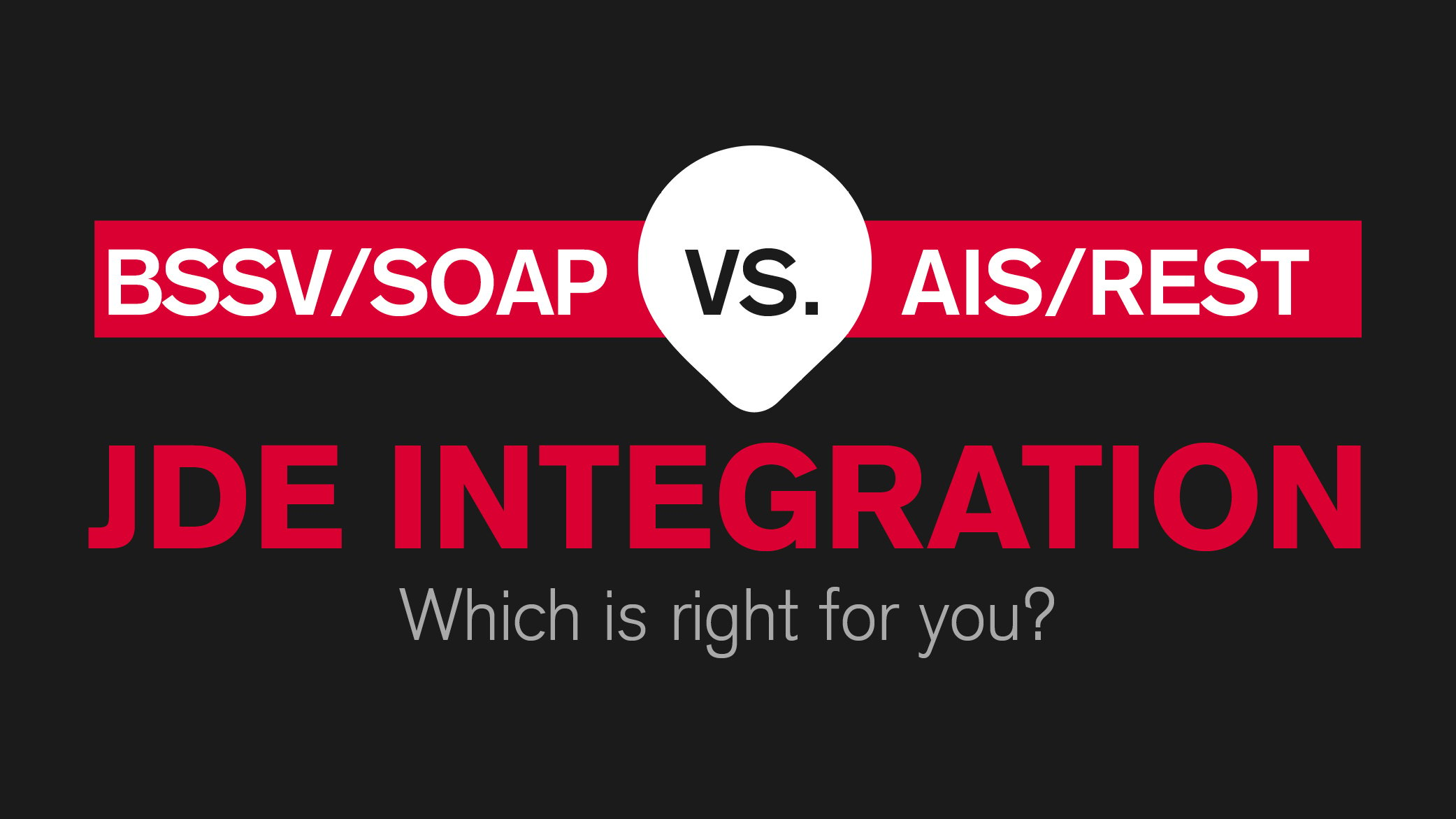


Today’s digital ERP occupies a prime space inside the modern organization. Still, it hardly works alone. Part of an ever-growing digital ecosystem, it must integrate with other applications and devices to achieve positive business outcomes. JD Edwards EnterpriseOne offers two major resource sets to bridge the divide. AIS or BSSV—which one is right for you?
JD Edwards Business Service (BSSV) holds the legacy position for integration with a decade of use cases. It’s a web service that uses Simple Object Access Protocol (SOAP) to pass data between applications. Standard protocol HTTP/HTTPS makes it easy for the SOAP model to tunnel across firewalls and proxies without modification. In this way, JD Edwards securely delivers more than 200 business services to external systems.
Keep in mind, BSSV typically requires a developer skillset including:
As a web service provider, BSSV enables third-party systems to invoke an EnterpriseOne (E1) business process. It may expose the address book, process a sales order, or retrieve item price availability, resulting in faster development. On the other hand, BSSV can call an external web service to pull information from a vendor. UPS® and FedEx have developed custom integrations using XML services to share tracking numbers. Similarly, SMC3 RateWareXL uses a BSSV consumer web service from an E1 business function to retrieve freight and transportation rates. By eliminating the need for periodic on-site data updates, companies who use BSSV save time and money
E1 Application Interface Services (AIS) is the newer tool on the block and rarely considered without JD Edwards Orchestrator Studio. Together they rely on Representational State Transfer (REST), a set of architectural principles, to transmit data over a standard interface such as HTTP/HTTPS. AIS exposes thousands of E1 applications and data for mobile apps, Composed Pages, notifications, orchestrations, and more.
AIS/REST calls are typically easier to create and consume than a BSSV/SOAP model. Developers can generate calls from Java or any programming language that can serialize/deserialize JSON, such as JavaScript or Python. Orchestrator Studio further simplifies the process by enabling business analysts to create orchestrations with little to no development knowledge.
If BSSV is the method of choice for large integrations, AIS claims mobility. AIS/Orchestrator easily integrates JD Edwards with digital devices from smartphones and tablets to Raspberry Pi, Arduino, and manufacturing IoT. You can use the lightweight interface to access tasks, build apps, and duplicate user experience across multiple devices. Here at ERP Suites, we leverage AIS and orchestrations to design JD Edwards mobile apps and provide base functionality for our barcode scanning tool.
BSSV/SOAP |
AIS/Orchestrations REST |
|
Standards based for Enterprises (WSDL using XML-based language to provide a contract between client and server) |
REST is more loosely defined, but used extensively by lightweight clients like mobile devices, IoT, small transactions/inquiries, etc. |
|
Significant tools and skillsets needed to create and maintain business/web services. (E1 development, C++, Java, and XML skills) |
The application only needs to be able to parse the JSON data and handle it accordingly. Less development effort is usually needed |
|
Provides reliable messaging, transactions, and transport independence. The exposed published interface is more “hardened” |
Content is delivered in the simplest way possible. REST web services are by design to be simple |
|
Larger enterprises tend to provide both SOAP and REST services |
Web 2.0 tends to provide web services using REST which tends to have less overhead than SOAP |
Free from advanced development, the AIS/Orchestrator model helps users to realize quick wins. Since you can use REST calls to input data, projects eliminating manual data entry are another great place to start.
Despite rumors, Oracle is not deprecating BSSV. It still has many uses. However, if you’re new to BSSV, look to AIS/Orchestrator first. REST calls can complement and, in some cases, replace business services. The point of entry and cost of development are typically much less too.
We’re here to help if you need us. ERP Suites provides comprehensive technology solutions to help companies not just identify IT’s potential but realize IT. Get JD Edwards CNC and orchestration support from ERP Suites.
Frank Jordan is a CNC technology consultant with over 300 customer engagements. Read Frank Jordan's blog on JD Edwards and ERP technology. His work with JD Edwards Orchestrator Studio earned ERP Suites three Distinguished Partner Awards for digital innovation at Oracle Partner Summit. Frank is the co-author of Advanced Tuning for JD Edwards EnterpriseOne Implementations and a frequent conference presenter.